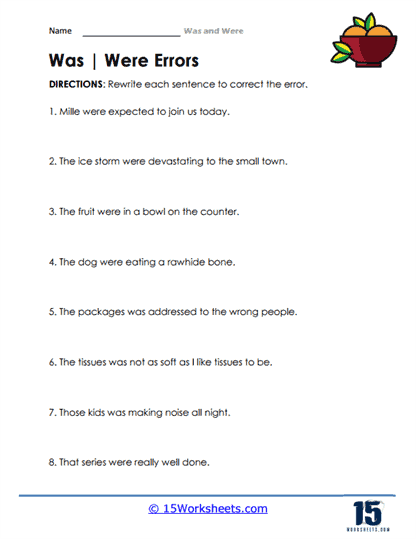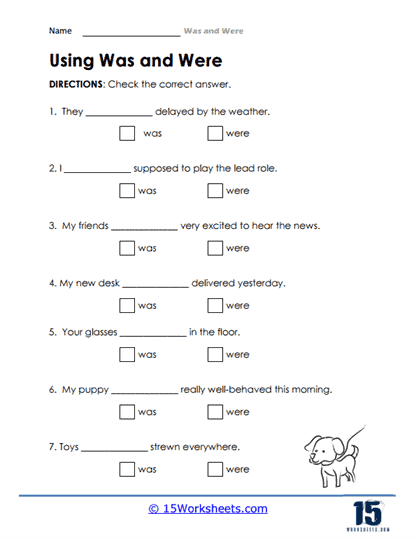Was Or were Worksheet
Are you struggling to master the basics of English grammar, especially when it comes to choosing between “was” and “were”? You’re not alone.
These simple words often trip up learners, causing confusion and frustration. But don’t worry—there’s an easy way to get a handle on it. Imagine confidently using “was” and “were” in your sentences, knowing you’ve nailed it every time. This article is your go-to guide, offering a specially designed worksheet that makes learning these tricky verbs a breeze.
Dive in to discover tips, tricks, and exercises that will transform your understanding and boost your grammar skills. Ready to make English grammar easier? Let’s get started!

Credit: www.pinterest.com
The Basics Of Was And Were
Wasand wereare forms of the verb “to be.”They help us talk about the past. Wasis used with singular nouns. It goes with “I,” “he,” “she,” and “it.” Wereis used with plural nouns. It goes with “you,” “we,” and “they.”
Example: He washappy. They werehappy. It’s important to know which form to use. This helps make sentences clear. Practice is key. Try using these words in sentences. You’ll get better with practice.
Grammar Rules
Singular subjects use “was”. Like: “He was happy.” Plural subjects use “were”. Example: “They were playing.” Singular means one. Plural means more than one. It’s simple. Just remember one rule: one uses “was”; more uses “were”.
Use consistent tense in sentences. If past tense starts, keep it past. Example: “He was tired. He slept early.” Don’t mix tenses. It confuses. Past uses “was” or “were”. Stay consistent. It’s easy. Just follow the rule.
Common Mistakes
Many people mix up singularand pluralforms. “Was” is for singular. “Were” is for plural. This is easy to forget. For example, “The cat wassleeping.” Here, “cat” is one. So, use “was”. “The cats wereplaying.” Here, “cats” are many. So, use “were”. Always check the numberof subjects. This helps in choosing the right word.
Some people use the wrong tense. “Was” and “were” are past tenses. Use them for past actions. “I washappy yesterday.” This shows the past. “They wereat the park last week.” This also shows the past. Always think about whenthe action happened. If it is past, use “was” or “were”. This avoids mistakes.
Practical Exercises
Complete these sentences with wasor were. Use the correct word. Example: She washappy. You werelate. 1. The birds _____ singing. 2. My friends _____ at the park. 3. The cake _____ delicious. 4. The children _____ excited. 5. Her book _____ interesting.
Find mistakes in these sentences. Fix them using wasor were. Example: They was playing. Correction: They wereplaying. 1. The cat were sleeping. 2. We was ready. 3. She were reading. 4. The teacher were kind. 5. The sun was shining.
Tips For Mastery
Flashcards can help with learning. Write “was” on one side. “Were” on the other side. Use them daily. This helps in quick recall. Create a song or rhyme. This makes learning fun. Visual aids are helpful too. Draw a chart. Label with examples. Hang it on your wall.
Practice makes things easier. Write sentences daily. Use both “was” and “were”. Check them with a friend. Workbooks are useful. They have exercises inside. Practice online too. Many websites offer quizzes. Try group activities. Play games using “was” and “were”. Learn together with friends. This makes practice fun.

Credit: 15worksheets.com
Resources For Learning
Online worksheets help kids learn easily. They are fun and colorful. Children can practice “was” and “were” with these sheets. Many websites offer free worksheets. You can print them or use them online. These sheets have stories and sentences. Kids fill in the blanks with the correct word. This helps them understand better. Teachers use these sheets in class too. It’s a good way to learn English grammar. Kids enjoy learning this way. They feel happy and smart.
Interactive quizzes are fun for kids. They help in learning quickly. Kids see questions on the screen. They choose the right answer. Quizzes give feedback instantly. Kids know if they are right or wrong. This helps them learn faster. These quizzes make learning enjoyable. Parents and teachers can use them for practice. It’s a great way to improve grammar skills.

Credit: 15worksheets.com
Frequently Asked Questions
What Is A “was Or Were” Worksheet?
A “Was or Were” worksheet helps learners practice using “was” and “were” correctly. It’s an educational tool designed for students learning English grammar. These worksheets typically include sentences or exercises where learners choose between “was” and “were” based on subject-verb agreement.
How Does A “was Or Were” Worksheet Help?
These worksheets enhance understanding of past tense verb usage. They improve grammar skills by offering practical exercises. Learners can better grasp subject-verb agreement, leading to more accurate language use. Such practice is crucial for mastering English grammar fundamentals.
Who Can Benefit From These Worksheets?
These worksheets are ideal for English language learners and students. Teachers use them in classrooms for grammar lessons. They’re also beneficial for anyone wanting to improve their English language skills. Practice with these worksheets can enhance both writing and speaking abilities.
Are “was Or Were” Worksheets Suitable For All Ages?
Yes, they are suitable for all age groups. They can be tailored to different learning levels and ages. Beginners, intermediate, and advanced learners can all benefit. Teachers can adjust the difficulty to match student needs.
Conclusion
Worksheets on “was” and “were” can boost language skills. They offer practice for correct verb usage. Understanding these verbs aids in sentence construction. Regular practice helps in building confidence. Mistakes lessen with frequent exercises. Worksheets make learning engaging and fun.
They simplify complex grammar rules. Suitable for all ages wanting to improve English. Consistent use leads to better fluency. Start using these worksheets today for improved grammar skills. Your English will get clearer and more precise. Happy learning!






